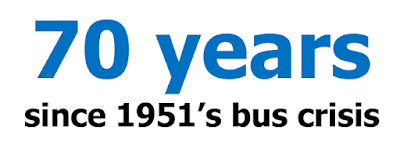70 years ago newspapers reported on a crisis that was the start of three or four decades of bus patronage falls and service cuts.
This was the era when rights to run bus routes were allocated by government but there was no state subsidy. Bus routes had to earn their keep from their fare box revenue.
1951 was very different from the more protected Melbourne bus scene of 2021, where, provided you've obtained or inherited a long term contract you can't really go wrong even if no one rides your buses. Today duplicative and poorly used bus routes that do not even stack up on social equity grounds routinely attract public subsidy for years without serious review or reform.
Bus companies (which were numerous and small in those days) charged and collected their own fares. They could apply for fare increases but they were not always granted by the government that regulated fares. And if they were there was the risk that they could lose patronage to a cheaper operator running a nearby route. And, especially in older suburbs, routes were often both short and close together.
The problems of 1951 were caused by two matters outside the bus industry's control.
Firstly there was the end of wartime petrol rationing in 1950. When that ended people could drive their cars further without restriction. Which they did. This contributed to the fall in public transport use off from its peak in about 1945. Public transport usage narrowed to become more housewives, schoolchildren and peak CBD commuters, although buses had some reprieve due to growth of suburbs beyond the tram tracks and away from stations. The non-conversion or closure of some trams also put more people onto buses, though the replacement routes were government rather than privately run.
Secondly there was the Korean war, wool boom and the resultant high inflation (history of which is here). This increased costs for bus operators since wages were regulated and unionisation was high. With static or falling patronage they had to hike fares to break even, which risked further losses. Or, to stem losses, abandon their routes. Survivors generally did so by buying out weaker operators and running longer combined routes. This lessened the need to change (which was good) but frequencies and operating hours were often reduced (which was bad for passengers but reduced operating costs).
That's the 'big picture' background. Here are some Trove articles, ordered by date, that discuss route by route details.* 13 July 1951 https://trove.nla.gov.au/newspaper/article/244238441 & https://trove.nla.gov.au/newspaper/article/205340109 & https://trove.nla.gov.au/newspaper/article/244237896
Loss of East Malvern bus service and calls for extension.
* 27 July 1951 https://trove.nla.gov.au/newspaper/article/205340381
Self-help scheme to revive bus. (Note there have been other community-led schemes, most recently
Wynbus in the City of Wyndham).
Chamber of Commerce to run Hughesdale bus.
* 10 September 1951 https://trove.nla.gov.au/newspaper/article/205336844
Bus companies threaten to abandon routes (some listed) if government does not grant fare rises
* 17 September 1951 https://trove.nla.gov.au/newspaper/article/244240774
Elsternwick - Point Ormond bus route to close.
Account of a route being abandoned despite operator being granted a fare rise (the route concerned is a predecessor to today's 623).
* 23 October 1951 https://trove.nla.gov.au/newspaper/article/205328097
Up to 13 routes to cease.
* 24 October 1951 https://trove.nla.gov.au/newspaper/article/247847349
Higher fares blamed for lower bus use and a shift to cycling.
* 29 October 1951 https://trove.nla.gov.au/newspaper/article/247849282
Mont Albert - Kew converted to school bus only (today the area has few regular routes but many school routes especially around Barkers Rd)
* 1 March 1952 https://trove.nla.gov.au/newspaper/article/246052811
This 1955 Government Gazette summaries buses as they were in 1955.
Earlier and later crises and successes
A decade later we were in war. It's well-known that fuel rationing limited private travel. However public transport use was high and people were only encouraged to use it for necessary trips. Bus companies were required to trim their routes to lessen overlap, cut competition with the railways and reduce wasteful duplication.
Dependence on state funding tied buses' fate to public finances. There were long periods in the 1970s and 1990s where buses simply did not expand to serve suburban growth areas. We remain with these 30 or 40 year service backlogs in areas like Knox, Chirnside Park and the Mornington Peninsula. There were also large state-imposed cuts, eg in 1990 and almost exactly 30 years ago in 1991 following a bus contracting bungle a couple of years prior. Again in 2021 timetables remain with the axe-marks of those early '90s cuts as visible now as the day they were made.

No comments:
Post a Comment